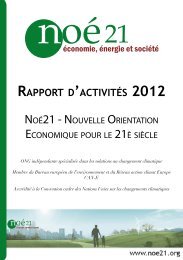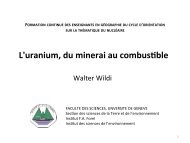As a Remedy to Global Warming, As a Remedy to Global Warming
As a Remedy to Global Warming, As a Remedy to Global Warming
As a Remedy to Global Warming, As a Remedy to Global Warming
Create successful ePaper yourself
Turn your PDF publications into a flip-book with our unique Google optimized e-Paper software.
<strong>As</strong> a <strong>Remedy</strong> <strong>to</strong><strong>Global</strong> <strong>Warming</strong>,By Richard ConniffThere was a time, in the 1990s,when forests seemed <strong>to</strong> offeran almost miraculous remedy<strong>to</strong> the problem of globalwarming. It’s an idea that has persistedin the public imagination. But for muchof the past decade, until now, forestshave been sidelined in the debate overpublic policy on global warming.Almost everyone, from universityresearchers <strong>to</strong> rock stars and electric utilityexecutives, accepts the basic premise:Because trees remove carbon dioxide fromthe atmosphere through pho<strong>to</strong>synthesis, theyrepresent a part of any serious response <strong>to</strong>global warming. Take away the water, anda tree is about 50 percent carbon by weight.But from this starting point, discussion aboutthe value of forests quickly gets complex,chaotic and, at times, a little surreal.Do Forests Matter?By planting one tree for every 60 fansattending their concerts, for instance, theRolling S<strong>to</strong>nes announced in 2003 that theywould render an entire <strong>to</strong>ur “carbon neutral”—that is, it would contribute no net carbondioxide <strong>to</strong> the atmosphere. Since the calculationincluded the cost of getting everyone <strong>to</strong> andfrom the stadium, these were possibly thehardest-working trees in rock-and-roll. The forprofitCarbon Neutral Company, formerly anonprofit called Future Forests, which handledthe S<strong>to</strong>nes effort, also calculated that itsreforestation projects had rendered theproduction of 30 million CDs “carbon neutral,”for groups from Coldplay <strong>to</strong> the Foo Fighters.That same year, U.S. electric companiesannounced that they would offset 700,000metric <strong>to</strong>ns of carbon dioxide emissions frompower plants, with projects ranging from smallurban plantings <strong>to</strong> participation in a NatureConservancy effort <strong>to</strong> protect 153,000 acres ofrainforest in northwestern Belize. The U.S.Energy Information Administration, whichtracks such voluntary efforts, reported that“one large sugar maple is capable of removingmore than 450 pounds of carbon dioxide fromthe atmosphere in a year.” Then, with a leap ofthe statistical imagination, it calculated that“preserving approximately 31 trees peroperating au<strong>to</strong>mobile in the United Stateswould offset all U.S. au<strong>to</strong>mobile-related carbondioxide emissions.”Broad claims like that have elicitedskepticism about the value of forests in theglobal-warming debate. For instance, anotherU.S. government report says sugar maples willdisappear from New England late in thiscentury because of global warming. So would31 loblolly pines suffice instead? What about31 seedlings? And how many trees would it take<strong>to</strong> offset a Mercedes-Benz Grand Sports Tourer,which the Rolling S<strong>to</strong>nes are currentlyendorsing as part of their “A Bigger Bang” <strong>to</strong>ur,with no claims <strong>to</strong> carbon neutrality?Fall 2005 3








